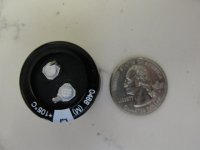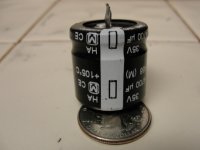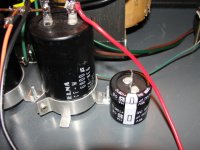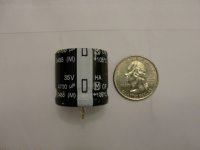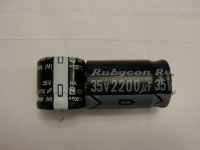I stopped by a local surplus shop few days ago and saw some new 4700uf 35v caps cheap. They are rated at 105C and have a relatively small size (about diameter of a quarter and less than 1" of height) compare to their rated capacity. But I couldn't stop the temptation to buy them so I did. I just built a 1996 JLH dual rails amp with only a pair of 6800uF caps. I do hear small hums when I am close to the speakers so I know I have to improve the power supply.
I then used four of them (two in parallel, making a pairs) and added a pair of 1 ohm resistors to the original caps and form a dual rails C-R-C circuit. After readjusting the bias and offset, I put the unit to test. The JLH magic is gone ! The amp sounded less powerful and bass/midrange was weak. I then tried to bypass the 1ohm resistors and just let the new caps parallel with the existing cap. Same thing. I ended up removing the new caps and the magic is back.
The original pair of 6800uF caps is ELNA that I bought over 25 years ago. Even I forgot where I bought them and how much I paid. But they sound great, warm and very round. I thought the pair of old Elna would have already dried up over these years.
I used to think caps and just caps to filter our ripples. I thought the bigger the better. Definitely I now think that's more than that.......
I then used four of them (two in parallel, making a pairs) and added a pair of 1 ohm resistors to the original caps and form a dual rails C-R-C circuit. After readjusting the bias and offset, I put the unit to test. The JLH magic is gone ! The amp sounded less powerful and bass/midrange was weak. I then tried to bypass the 1ohm resistors and just let the new caps parallel with the existing cap. Same thing. I ended up removing the new caps and the magic is back.
The original pair of 6800uF caps is ELNA that I bought over 25 years ago. Even I forgot where I bought them and how much I paid. But they sound great, warm and very round. I thought the pair of old Elna would have already dried up over these years.
I used to think caps and just caps to filter our ripples. I thought the bigger the better. Definitely I now think that's more than that.......
Hello!
Just a thought here, but perhaps your 25 years old ELNA's have lost most of their capacitance over the years. That's probably causing the slight hum you've experienced - you are listening to an amplifier with VERY small filter capacitance, but this is also responsible for the kind of sound you got used to.
Now, with proper capacitance in place, you might just hear how your amp "really" sounds.
There are a few topics discussing the influence of small vs. large capacitance of power supply filter caps, first and foremost the LM3875-GainClone kind of amp. They're said to sound magic only if the ps-smoothing capacitance is very small, in the range 1000uF per rail.
Maybe this is all wrong, but as said, just a thought...
Regards!
Martin
Just a thought here, but perhaps your 25 years old ELNA's have lost most of their capacitance over the years. That's probably causing the slight hum you've experienced - you are listening to an amplifier with VERY small filter capacitance, but this is also responsible for the kind of sound you got used to.
Now, with proper capacitance in place, you might just hear how your amp "really" sounds.
There are a few topics discussing the influence of small vs. large capacitance of power supply filter caps, first and foremost the LM3875-GainClone kind of amp. They're said to sound magic only if the ps-smoothing capacitance is very small, in the range 1000uF per rail.
Maybe this is all wrong, but as said, just a thought...
Regards!
Martin
Andrew...I don't think I have the knowledge to work out which is not up to spec. But I remember I came across your statement that the C closest to the amp is more important in terms of sound.
Martin....The 25 years old Elna caps were not really used. They were pretty much sitting in the storage. The hum is not bad, I cannot hear it when I'm more than 1 feet away from speakers, and there has to be no music to hear the hum. I don't know about if smaller caps are good to JLH but I have read enough here that people are using much bigger caps than I do for their JLHs. I know class A needs really good filtering.
I think I will save some money and buy better caps down the road. I think the good sound now is due to the JLH schematic and the ELNA. I heard people praising ELNA caps here.....
AC
Martin....The 25 years old Elna caps were not really used. They were pretty much sitting in the storage. The hum is not bad, I cannot hear it when I'm more than 1 feet away from speakers, and there has to be no music to hear the hum. I don't know about if smaller caps are good to JLH but I have read enough here that people are using much bigger caps than I do for their JLHs. I know class A needs really good filtering.
I think I will save some money and buy better caps down the road. I think the good sound now is due to the JLH schematic and the ELNA. I heard people praising ELNA caps here.....
AC
You can fairly easily measure leakage current.
You can fairly easily measure discharge time at a fixed current.
With quite a bit of research you can measure ESR.
A ClassAB amplifier draws little quiescent current when idling. This low current demand allows the smoothing capacitance to deliver a very low ripple DC to the amp.
The amplifier then attenuates the line ripple and with luck and good design you do not hear the hum when the music is not playing.
A ClassA amplifier draws a continuous quiescent current when idling. This high current demand results in a higher ripple on the DC supply to the amplifier. It's the job of the well designed amplifier to reduce the hum down to an inaudible level when no music is playing.
The ClassA quiescent current can easily be 100 times the ClassAB quiescent current. This makes the ripple ~40dB worse for the ClassA situation.
Either reduce the ripple or increase the hum attenuation or do a bit of both.
You can fairly easily measure discharge time at a fixed current.
With quite a bit of research you can measure ESR.
this is not strictly true.I know class A needs really good filtering.
A ClassAB amplifier draws little quiescent current when idling. This low current demand allows the smoothing capacitance to deliver a very low ripple DC to the amp.
The amplifier then attenuates the line ripple and with luck and good design you do not hear the hum when the music is not playing.
A ClassA amplifier draws a continuous quiescent current when idling. This high current demand results in a higher ripple on the DC supply to the amplifier. It's the job of the well designed amplifier to reduce the hum down to an inaudible level when no music is playing.
The ClassA quiescent current can easily be 100 times the ClassAB quiescent current. This makes the ripple ~40dB worse for the ClassA situation.
Either reduce the ripple or increase the hum attenuation or do a bit of both.
Last edited:
Try Elna Silmic
I've had some VERY good results using Elna Silmic caps in power supplies. So far, they have sonically surpassed a bunch of other highly rated caps, Nichicon, Panasonic, Blackgates, etc. There is definitely something special about some of those Silmics. (Maybe not all of them, I haven't tried much beyond the 4700uF variety).
Yes, there are many here who would say "It only makes a difference if the specs are different"....but there are also others, like me, who do hear a difference, even when our regular testing procedures wouldn't point that way. Bottom line, you're not out to satisfy anyone other than yourself, so explore this more.
If, as you have found, you are hearing a difference, then you might want to look into the more recent Elna' offerings and compare. I have... and I like 'em. A lot.
Best Wishes on your continued exploration.
I've had some VERY good results using Elna Silmic caps in power supplies. So far, they have sonically surpassed a bunch of other highly rated caps, Nichicon, Panasonic, Blackgates, etc. There is definitely something special about some of those Silmics. (Maybe not all of them, I haven't tried much beyond the 4700uF variety).
Yes, there are many here who would say "It only makes a difference if the specs are different"....but there are also others, like me, who do hear a difference, even when our regular testing procedures wouldn't point that way. Bottom line, you're not out to satisfy anyone other than yourself, so explore this more.
If, as you have found, you are hearing a difference, then you might want to look into the more recent Elna' offerings and compare. I have... and I like 'em. A lot.
Best Wishes on your continued exploration.
Last edited:
Thanks again Andrew. I will dig a little deeper about measuring those cheap caps. But I think I get what I paid for. The caps (4700uF 35v) has no brand name and only cost me 50 cents (US$) each.
Jack: I'd definitely like to try a more recent version of ELNAs. I went to mouser.com last night but can't find them. Can you suggest any reliable web parts stores ? I don't want to buy electronics from ebay.
Jack: I'd definitely like to try a more recent version of ELNAs. I went to mouser.com last night but can't find them. Can you suggest any reliable web parts stores ? I don't want to buy electronics from ebay.
Try a simple experiment with the new caps to see if they are truly 4700uF.
Its not accurate but discharge them and then wire them across a battery with a known resistor.
Calculate t=0.7RC and measure them with a stopwatch to see how long they take to get to about 70% of Vcc.
As I said, its not perfect but it will indicate if the caps are about 4700uF.
Its not accurate but discharge them and then wire them across a battery with a known resistor.
Calculate t=0.7RC and measure them with a stopwatch to see how long they take to get to about 70% of Vcc.
As I said, its not perfect but it will indicate if the caps are about 4700uF.
A myth is that aging electrolytics loose their capacitance. Having a cap-meter and a tan-delta-meter, I have tested more than two thousands of them. I'do not remember some having significative capacitance loss. More often it is that the ESR which has increased, but less often than may be thought.perhaps your 25 years old ELNA's have lost most of their capacitance over the years.
Thanks again for more ideas. I'm working a couple of night shifts in a row and will be off Wed. I will take some pics, do some measurements and post result. I hope I can find a way to measure ESR as well. I do not have a scope nor a capacitance meter, only regular bench tools such as a voltage adjustable regulated power supply and a couple of multimeters.
I pulled and measured six big Elna (IIRC) PS caps out of a late 70's HK power amp and they all came out 15-20% short of nominal. The replacement Panasonic TSs all tested over their rated values. I can't say that the Elnas weren't below spec when they went in, but it seems unlikely. A sample of six isn't particularly statistically worthwhile compared to a couple of thousand, but my experience was pretty consistent and contrary to yours.A myth is that aging electrolytics loose their capacitance. Having a cap-meter and a tan-delta-meter, I have tested more than two thousands of them. I'do not remember some having significative capacitance loss. More often it is that the ESR which has increased, but less often than may be thought.
Regards,
Jim W.
Hi Jim W
15-20% short of nominal value of capacitance is not very significative for electrolytics.Below a link to a catalog of a french manufacturer which provides useful information about their life.
http://www.microspire.com/fichiers/catalogues/20111129_160825_catalogue_sic_safco_2010.pdf
I do not remember having seen a faulty cap from this manufacturer, even old, their specs are usually impeccable or, at least, never need replacement.
Some years ago, I built Cyril Bateman's tan-delta-meter. As no more than one of my caps stock seems to be faulty when tested, Cyril sent me some samples of really faulty caps to proove that they exist and that the device he conceived works well.
I primarily built this tan-delta-meter to check electrolytics of professional electronic flashes for photographers which delivers huge amounts of current in a few ms. They were more than 30 years old and have been used a lot. Having all a tan-delta inferior to 0.01, none had to be rejected.
15-20% short of nominal value of capacitance is not very significative for electrolytics.Below a link to a catalog of a french manufacturer which provides useful information about their life.
http://www.microspire.com/fichiers/catalogues/20111129_160825_catalogue_sic_safco_2010.pdf
I do not remember having seen a faulty cap from this manufacturer, even old, their specs are usually impeccable or, at least, never need replacement.
Some years ago, I built Cyril Bateman's tan-delta-meter. As no more than one of my caps stock seems to be faulty when tested, Cyril sent me some samples of really faulty caps to proove that they exist and that the device he conceived works well.
I primarily built this tan-delta-meter to check electrolytics of professional electronic flashes for photographers which delivers huge amounts of current in a few ms. They were more than 30 years old and have been used a lot. Having all a tan-delta inferior to 0.01, none had to be rejected.
Pics here...
Hi eveybody.....I managed to take some pics today (after 3x12 hrs night shifts). As you can see the 4700uF is non-brand, and very small size (pics taken with a US quater by its size). You can also see its size in compare to my great sounding antique ELNA 6800uF cap. There is another pic that compare it to an old 2200uF Rubycon.
I haven't been able to find simple way to measuring ESR. The information I found involves equipments I don't have - sig gen and an OSC scope.
But then again, I went to digikey and mouser and can't find newer ELNAs that are comparable to the size I'm using. Biggest one is about 3300uF. ARe these all they are making now ? Nothing bigger than 3300uF ?
I also search for Panasonic FM in digikey and mouser and they don't have it. They are listing different Panasonic series that are not FM. I'm kind of lost but I want to avoid buying caps from Ebay if by all means possible. Where do you guys buy your filtering caps from ?
This is my thread of the JLH I built:
http://www.diyaudio.com/forums/solid-state/207482-my-jlh-1996-evo-output-transistors-questions.html
regards,
-AC
Hi eveybody.....I managed to take some pics today (after 3x12 hrs night shifts). As you can see the 4700uF is non-brand, and very small size (pics taken with a US quater by its size). You can also see its size in compare to my great sounding antique ELNA 6800uF cap. There is another pic that compare it to an old 2200uF Rubycon.
I haven't been able to find simple way to measuring ESR. The information I found involves equipments I don't have - sig gen and an OSC scope.
But then again, I went to digikey and mouser and can't find newer ELNAs that are comparable to the size I'm using. Biggest one is about 3300uF. ARe these all they are making now ? Nothing bigger than 3300uF ?
I also search for Panasonic FM in digikey and mouser and they don't have it. They are listing different Panasonic series that are not FM. I'm kind of lost but I want to avoid buying caps from Ebay if by all means possible. Where do you guys buy your filtering caps from ?
This is my thread of the JLH I built:
http://www.diyaudio.com/forums/solid-state/207482-my-jlh-1996-evo-output-transistors-questions.html
regards,
-AC
Attachments
The printing on those Panasonic caps looks a bit suspect to me....
I don't have any panasonic caps in my pictures. Are you sure you are seeing panasonic ?
I don't have any panasonic caps in my pictures. Are you sure you are seeing panasonic ?
The (M) logo is that of Matsushita, also known as Panasonic.
Your pictures presumably show a TS-HA series cap. According to the datasheet, the 35V/4700uF type should be of around 25mm diameter and height.
Additionally, the 0488 marking looks like a production code of week 4 in 1988.
Last edited:
- Status
- This old topic is closed. If you want to reopen this topic, contact a moderator using the "Report Post" button.
- Home
- Amplifiers
- Power Supplies
- I thought it was a myth...
